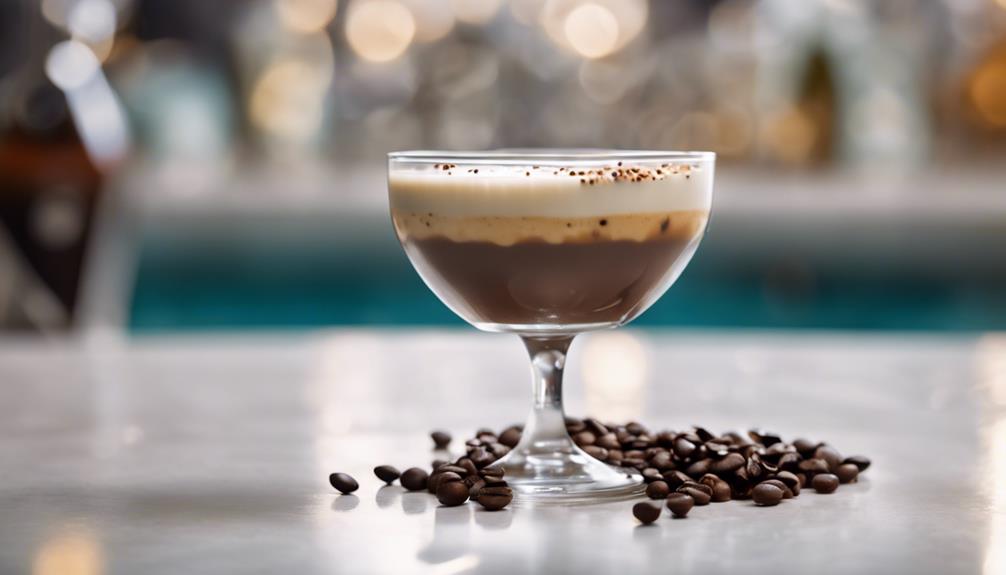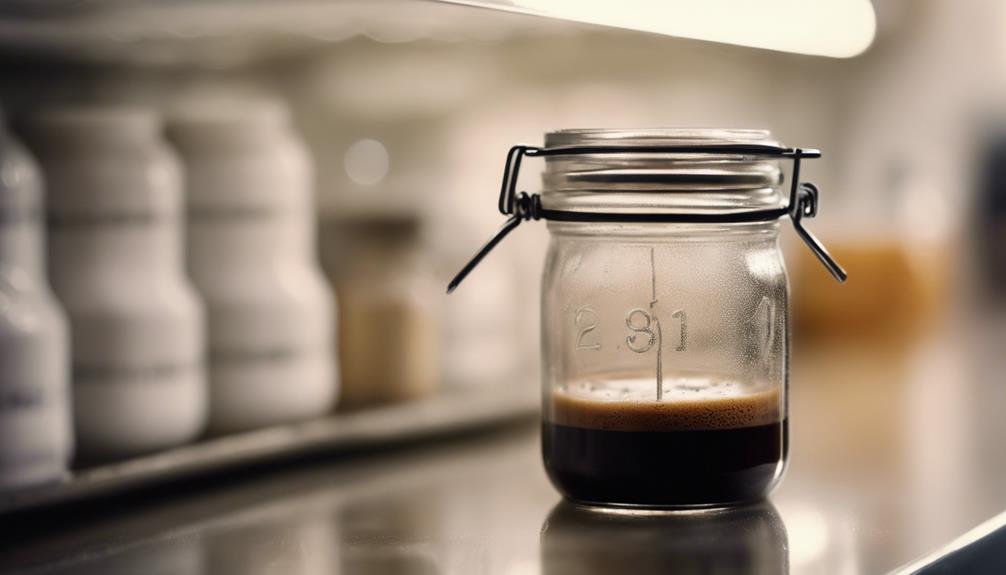Yes, the Espresso Martini can be made vegan by utilizing plant-based milk substitutes and vegan liqueurs. Almond, oat, or coconut milk can be used instead of dairy, while vegan-friendly coffee liqueurs like Tia Maria or Mr. Black provide suitable alternatives. Try experimenting with cold brew espresso, vodka, and sweeteners to create a homemade vegan version. Finish it off with a garnish of espresso beans or cocoa powder for an added touch. For a more in-depth look at vegan options, ingredients, and presentation ideas, delve further into plant-based milk substitutes, liqueur choices, cocktail recipes, helpful tips, and serving suggestions.
Key Takeaways
- Use vegan coffee liqueur like Tia Maria or Mr. Black.
- Substitute dairy with plant-based milk like almond or oat milk.
- Opt for dairy-free sweeteners such as maple syrup.
- Ensure all ingredients are free from animal products.
- Experiment with non-dairy cream alternatives for a vegan twist.
Plant-Based Milk Substitutes
To make an Espresso Martini vegan, opt for plant-based milk substitutes like almond milk, oat milk, coconut milk, or cashew milk. These dairy-free alternatives offer a creamy texture and richness to your coffee-infused cocktail without compromising on flavor.
Almond milk, with its subtle taste, is a popular choice, while oat milk brings a velvety smoothness to the drink. Coconut milk adds a tropical hint, and cashew milk contributes a nutty undertone, allowing you to customize your Espresso Martini to suit your preferences.
For those following a vegan lifestyle or individuals with lactose intolerance, plant-based milk options are ideal for enjoying this classic cocktail guilt-free. Whether you're seeking to reduce your dairy intake or simply prefer the taste of non-dairy milks, experimenting with different plant-based alternatives can help you discover the perfect complement to the bold espresso and sweet notes of the Martini.
Next time you mix up this iconic drink, consider reaching for a plant-based milk substitute to elevate your Espresso Martini experience.
Vegan Liqueur Options

Choosing the right liqueur is crucial for a fully vegan Espresso Martini, ensuring it aligns with your plant-based preferences.
When searching for vegan liqueur options for your cocktail, consider Tia Maria as a top choice. This vegan-friendly coffee liqueur combines sugar, Jamaican rum, and coffee extract to deliver a rich flavor without any animal-derived ingredients.
While Kahlua is a common coffee liqueur, it mightn't always be vegan due to potential milk or dairy components.
To create a vegan version of this classic cocktail, opt for plant-based milk alternatives like almond, oat, or coconut milk. You can also explore different vegan coffee liqueur brands such as Mr. Black or even experiment with making your own using natural ingredients.
If you prefer a creamier texture in your espresso martini, choose dairy-free alternatives to cream-based liqueurs like Baileys to keep your drink completely vegan-friendly.
Enjoy your vegan espresso martinis guilt-free with these thoughtful choices.
DIY Espresso Martini Recipe

Consider using plant-based milk, cold brew espresso, vodka, and sweeteners like maple syrup to craft your own vegan Espresso Martini at home.
Start by pouring 1 1/2 oz of cold brew espresso, 1 1/2 oz of vodka, 1 oz of plant-based milk, and 1/2 oz of maple syrup into a cocktail shaker filled with ice.
Shake vigorously for about 15-20 seconds until well combined and frothy.
Strain the mixture into a chilled martini glass to serve.
For a non-alcoholic version, skip the vodka and increase the amount of cold brew espresso and plant-based milk to maintain the balance of flavors.
Remember, the key to a perfect Espresso Martini lies in the quality of your ingredients and the art of mixing them.
Experiment with different ratios to suit your taste preferences.
Enjoy the rich, velvety texture and the strong coffee kick of this classic cocktail made vegan-friendly in the comfort of your home.
Tips for Making Vegan Cocktails

When crafting vegan cocktails, remember to choose plant-based milk varieties such as almond, oat, or coconut milk as dairy-free substitutes.
For a Dairy Free Espresso Martini, opt for vegan-friendly coffee liqueurs like Tia Maria or make your own dairy-free version.
Experiment with sweeteners such as maple syrup or agave nectar to guarantee your cocktail is vegan-friendly.
Verify that all ingredients, including spirits and mixers, are free from animal products to create a truly vegan cocktail.
If you wish to accommodate different preferences and dietary needs, consider exploring non-alcoholic options or alcohol-free versions of classic cocktails.
By incorporating plant-based milk, vegan-friendly coffee liqueurs, and alternative sweeteners, you can create delicious vegan cocktails that are both ethical and flavorful.
Remember to check labels and do your research to ensure all components of your cocktail align with your vegan values.
Cheers to enjoying a cruelty-free cocktail experience!
Serving and Presentation Ideas

Enhance the visual appeal of your Espresso Martini by garnishing it with espresso beans or a dusting of cocoa powder. Serving it in a chilled martini glass not only keeps the cocktail cold but also elevates the drinking experience.
To add a touch of sweetness and decorative flair, consider adding a splash of dairy-free caramel sauce, creating an enticing swirl in the glass.
When it comes to the creaminess of your cocktail, experiment with dairy-free milk alternatives like almond, oat, or coconut. For a unique twist, try using flavored syrups such as vanilla or hazelnut to customize the taste profile and enhance the complexity of your Espresso Martini without Kahlua.
If you're looking to make a classic espresso martini vegan, you can use cashew milk instead of traditional cream liqueurs like Baileys Irish Cream. For a fun variation, try incorporating a hint of Peanut Butter for a deliciously unconventional twist.
Remember to make sure all necessary elements are marked in your presentation to guarantee a visually appealing and well-rounded drink.
Frequently Asked Questions
Does an Espresso Martini Have Dairy?
Yes, an Espresso Martini can contain dairy. Traditional recipes often include cream or milk.
To make it vegan, opt for dairy-free alternatives like almond milk or oat milk. These alternatives can provide a creamy texture without compromising on taste.
Is Espresso Liqueur Vegan?
Espresso liqueur can be vegan if made without animal-derived ingredients. Some popular vegan options include Tia Maria, Mr. Black, and Patron XO Cafe. Check labels or contact the manufacturer for verification.
Vegan espresso liqueurs often use plant-based ingredients like sugar and coffee extract. Enjoy a dairy-free espresso martini by choosing a vegan coffee liqueur. Remember to confirm ingredients to make sure your drink aligns with your dietary preferences.
Is Kahlua Espresso Martini Dairy Free?
Kahlua Espresso Martini contains dairy, making it not dairy-free.
To enjoy a dairy-free version, choose vegan coffee liqueurs like Tia Maria or make your own.
Swap out dairy ingredients with plant-based milk or creamers for a dairy-free Espresso Martini.
Be sure to check labels for hidden dairy in coffee liqueurs before using them in a dairy-free recipe.
Experiment with various dairy-free options until you find the perfect mix for a vegan Espresso Martini.
What's an Espresso Martini Made Of?
An Espresso Martini is made of espresso, vodka, coffee liqueur, and sometimes a sweetener like simple syrup. This cocktail offers a rich coffee flavor with a touch of sweetness from the liqueur.
To create a vegan version, opt for dairy-free options like almond milk, oat milk, or coconut milk. Popular choices for dairy-free coffee liqueurs include Tia Maria or homemade vegan versions.
Achieve a creamy texture sans dairy by using plant-based milk alternatives like almond or oat milk.
Is Outback’s Espresso Martini Vegan-friendly?
Yes, Outback’s Espresso Martini is vegan-friendly. The Outback Espresso Martini availability is quite high at their locations, and it’s a great option for those looking for a vegan-friendly cocktail. With the delicious blend of espresso and vodka, it’s perfect for anyone looking for a vegan drink option.
Are Espresso Martinis typically made with vegan ingredients?
When it comes to finding vegan-friendly espresso martinis, it’s essential to choose the right places. Certain establishments offer vegan-friendly versions of this popular cocktail. If you’re on the lookout for vegan espresso martinis, make sure to check out the espresso martini top 7 places for a delicious and cruelty-free option.
Can I Make an Espresso Martini using Vegan-friendly Ingredients from Local Coffee Shops?
Looking to make a vegan-friendly Espresso Martini? Find the best coffee shops near you for non-dairy milk and vegan-friendly coffee liqueur. Local shops can offer the ingredients you need to create the perfect vegan Espresso Martini without compromising on flavor or ethics. Cheers to creating a cruelty-free cocktail masterpiece!
Conclusion
To sum up, the espresso martini can easily be made vegan by using plant-based milk substitutes and vegan liqueurs. With a few simple swaps and a DIY recipe, you can enjoy this classic cocktail without compromising your dietary preferences.
Experiment with different ingredients and presentation styles to elevate your vegan cocktail experience. Cheers to sipping on a cruelty-free espresso martini!









